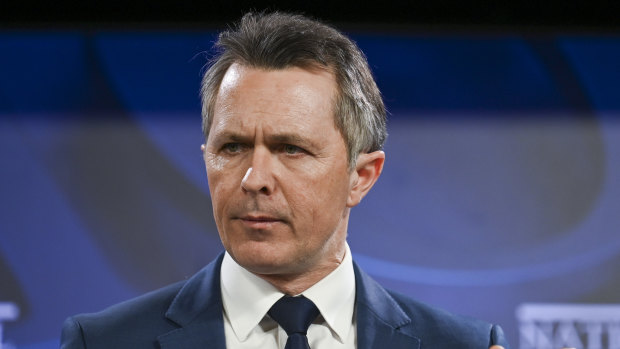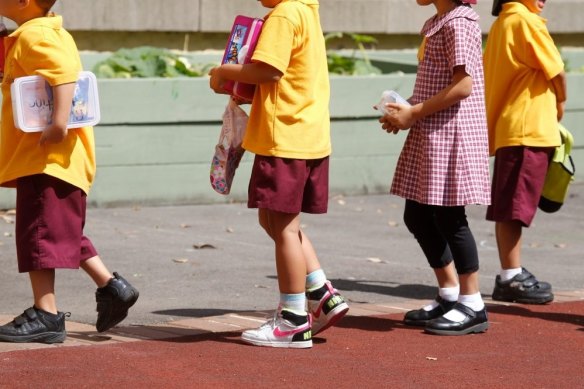Victorian public schools were shortchanged more than $1.7 billion last year under little-known loopholes and accounting tricks that economists warn are still allowing the states to underfund public schools.
The Commonwealth heads into critical negotiations with the states and territories for new funding deals this year and federal Education Minister Jason Clare has vowed to fix the funding gap that has left almost all the nation’s public schools underfunded and most of its private schools overfunded.
The Gonski reforms of more than a decade ago were supposed to fund schools according to need. But a Coalition-era watering down of the agreements mean the states, which cover the majority of public school costs, only have to show they are on a path to eventually reaching 95 per cent of the minimum agreed resourcing requirement, known as the Schooling Resource Standard (SRS).
The states, including Victoria, have been calling on the Commonwealth to fill the “missing 5 per cent” of that money.
But an analysis by this masthead, independent experts and the Australian Education Union reveals the funding shortfall is actually closer to 15 per cent in many jurisdictions, except the ACT which already fully funds public schools.
In Victoria, “the education state”, the funding gap will be almost 14 per cent this year, bigger than NSW, but less than the Northern Territory. That’s about $1.5 billion, after the $1.7 billion shortfall in 2023.

Education Minister Jason Clare.Credit: Martin Ollman
In Australia, the states are meant to cover 80 per cent of public school funding and 20 per cent of Catholic and private. Those responsibilities are reversed for the Commonwealth, which funds 80 per cent of the non-government sector but is capped at funding only 20 per cent for public schools.
The federal government is now paying that 20 per cent and has flagged increasing it further if the states step up too.
But economists say Clare must also close a key loophole that allows states to claim 4 per cent of their share of public school funding in capital depreciation and non-school spending.
The clause means that last year all states and territories, except the ACT, collectively claimed they spent $2 billion that never actually reached classrooms.
“Gonski was meant to be real money, for real schools,” said education economist Adam Rorris, who helped the Commonwealth devise the minimum standard requirements and analysed funding projections as part of independent work commissioned by the AEU.
“This is an accounting trick. It’s a rort. And it only applies to public schools, not the privates,” he said.
“The SRS is not a lofty aspiration. It’s the bare minimum needed”, calculated to get at least 80 per cent of students above the minimum standard for NAPLAN testing. “And we’re still nowhere close.”
Meanwhile, Rorris said, private school funding continued to grow in a way never intended by Gonski, overfunded by hundreds of millions of dollars a year until at least 2029.
Clare did not answer questions on whether he would scrap the 4 per cent allowance for states or introduce tougher accountability on their funding pledges, as Labor previously committed to do while in opposition.
But he stressed he was committed to the full 100 per cent funding standard.
“We have to fix the funding gap,” he said, adding short-term, extra resources should be targeted to “things that help children who fall behind catch up”, such as tutoring support.
AEU federal president Correna Haythorpe said under the 4 per cent loophole, jurisdictions could claim everything from regulatory agencies, early learning and even private school buses as part of their public school funding.
“The accountability has been stripped out of these deals and this [federal] government has a historic moment to fix it,” she said. “My nephew is about to start school. Will he go through another decade of underfunding?”

In Australia, the states are meant to cover 80 per cent of public school funding and 20 per cent of Catholic and private.Credit: Quentin Jones
Last month, a major report commissioned by the federal government called for public schools to be fully funded urgently, as the achievement gap between the richest and poorest students grows and inequality becomes “entrenched” in the school system. But most politicians have shied away from committing to a timeline.
So far, NSW has vowed to fully fund public schools by 2029 under the next deal with the Commonwealth.
In Victoria, where a tight budget looms ahead this May, a Department of Education spokeswoman said that since coming to power just under a decade ago, the Labor government had invested $14.9 billion in school infrastructure that was not included in SRS figures, and had ramped up its spending per student more than other states.
Victoria “continued to advocate” for more Commonwealth spending on public schools, she said, as “all students, no matter their circumstances, deserve the best start in life”.
Deakin University researcher Dr Emma Rowe has been surveying school principals across the country and says the divide between the school sectors is staggering.
“While you have one elite [private] school importing special limestone to build a literal castle, [public] principals across the board talk about the struggle with their budgets,” she said.
“They are fighting for absolutely everything, putting in lengthy applications for basics like heaters and airconditioning, working toilets.”
Some primary schools don’t have playgrounds. Others hold fetes and fundraisers to crowd-source extra funds.
Rowe said one principal “had been applying for five years to fix classroom windows that didn’t open or would slam shut suddenly, which could take off a little kid’s fingers. Another to fix a leaking roof creating mould.”
“Public schools are being starved of money. That’s why parents are going private.”
Education expert Matthew Sinclair agreed that Australia is unique on the world stage for the scale of its funding of private schools. Overseas, government support for private schools is very limited, and usually tied to the fees schools charge parents.
“Here, it’s unregulated,” Rowe said. “Fees are going up faster than house prices.”
Sinclair said there was no clear rationale to Australia’s funding split that leaves the majority of public school funding to the states, which have less revenue-raising power than the Commonwealth.
“Why couldn’t it be 50-50 for all schools? I think if it was better balanced, we’d be in a much better position,” he said, flagging the idea of a national agency to dole out money based on need.
“But the politics of entitlement ... the lobby groups of the private and the Catholic sector, keep trumping the reality of need [for] our students.”
With Emma Koehn
Start the day with a summary of the day’s most important and interesting stories, analysis and insights. Sign up for our Morning Edition newsletter.